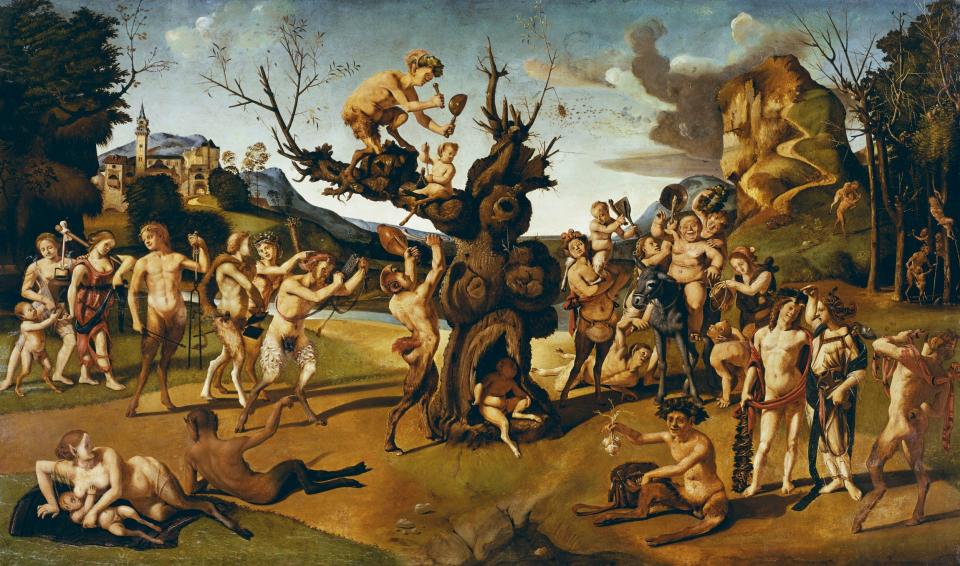Florentine Renaissance artist Piero di Cosimo (1462-1522) was a strange man. He lived on a diet consisting solely of eggs, which he boiled in batches of 50 in water from which he prepared his glue. He lived in filth, unclean rooms and a rambling garden. He was afraid of thunderstorms, loud coughs and the chanting of priests. The ideas for his paintings came from staring for hours at a wall where sick people had emptied their saliva; He saw cities, landscapes and wars in the dirty traces he left behind. Towards the end of his life, according to Giorgio Vasari, “he was so strange and eccentric that nothing could be done to him”.
The Piero depicted by Rutgers art history professor Sarah Blake McHam is quite different. In his informative study, the artist, less well known than his direct colleagues Botticelli, Leonardo and Michelangelo, emerges as an underappreciated figure in the history of Renaissance art.
Born Piero di Lorenzo to a Florentine blacksmith – his later surname derived from his apprenticeship with the artist Cosimo Rosselli – Piero had a much luckier career than his tales of eccentricity would suggest. After a successful apprenticeship in which he helped his master paint a scene for the Sistine Chapel, his career was on solid ground. It was the golden child of wealthy aristocrats who wanted to adorn their homes with scenes from Greek and Roman myths, and the favored choice of patrons seeking the unique blend of whimsy and detail in their religious paintings. (In one scene of Mary’s visit to Elizabeth, he added a monkey climbing to the top of a palace as if on a tightrope.)
But despite his success, Piero was somewhat forgotten in the polls of Renaissance artists. A major exhibition of his work did not open at America’s National Gallery of Art until 2014, and he only received academic attention in 1946 with a monograph by Robert Langton Douglas. But institutional and academic fame is not everything. Piero had other admirers, too. George Eliot made her a character in Romola, her novel about Renaissance Florence, and the Surrealists of the 1930s considered her their extraordinary ancestor.
Blake McHam’s book is part of a resurgence of interest in Piero in recent years. Blake McHam tells us that this is not a biography, very thin on detail other than what appears to have been invented by Vasari, and not a study of the “development” of Piero’s style. He adds that this would be “treasonous”. , because any chronology is impossible if so few paintings are dated – instead the study of different genres of Piero’s art: his secular myths and legends, his portraits, altarpieces and private devotional paintings.


In the hands of Blake McHam, the full scope of Piero’s talent is explored. Although he had no literary education, he died without a book in his hand; There is a question mark as to whether he can write; Piero’s earthly scenes are able to package old myths in new ways. The large panels depicting human prehistory (Hunting Scene, Return from the Hunt, and Forest Fire) are grim. Animal-like humans pursue human-like animals with “blood-curdling pleasure.” It turns out that early humans were little more than cannibals. These images are radical in Renaissance art, but they came from nowhere: Piero was painting in response to the works of Lucretius, Vitruvius, Pliny, and Boccaccio. Either the painter was better educated than thought, or his patrons knew what details from classical texts they should tell him to exercise his unconventional imagination.
Blake McHam also illuminates Piero’s unique approach to religious painting. In Vasari’s account, the artist’s comment that he is constantly “pursuing challenges” is a reference not only to his technical flourishes but also to the theology of his paintings. In one of his altarpieces, Bari and the Visitation of Anthony Abbot, the normal chronology of biblical stories is subverted in favor of something much more experimental: the stories are painted like frescoes within the landscape of the painting, or so they should be disguised. was searched. Instead of being a site of Christian doctrine, the altarpiece evolved into something more experimental: a religious puzzle, an exegetical dance.
This book does a great job of exploring Piero’s context: the literary background of his work; His connections with other painters, from Botticelli to Leonardo. But it’s hard not to feel that something is missing: his Piero is unorthodox but not eccentric; idiosyncratic but not spectacularly strange. The extent of his real-life eccentricities (images of cannibalism, tendency towards perversion) is occasionally minimized in an attempt to distract him from egg-eating myths (Blake McHam suggests that Vasari wrote them because he was disappointed with Piero’s output). But it’s not Blake McHam’s fault that he can’t come up with a story to replace the myths. Without the facts needed to write a biography, this is a delightful, thoughtful study of the Renaissance’s most playful, surprising artist.
Authored by Francesca Peacock. Pure Intelligence: The Revolutionary Life of Margaret Cavendish. Piero di Cosimo is published by Reaktion, priced at £17.95. To order your copy, call 0844 871 1514 or visit: Telegram Books